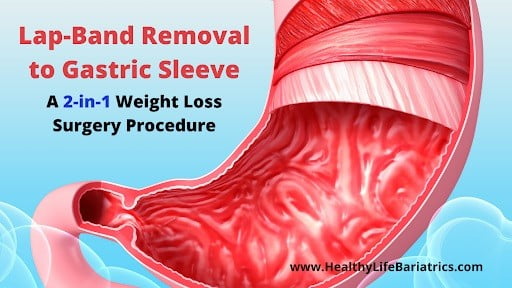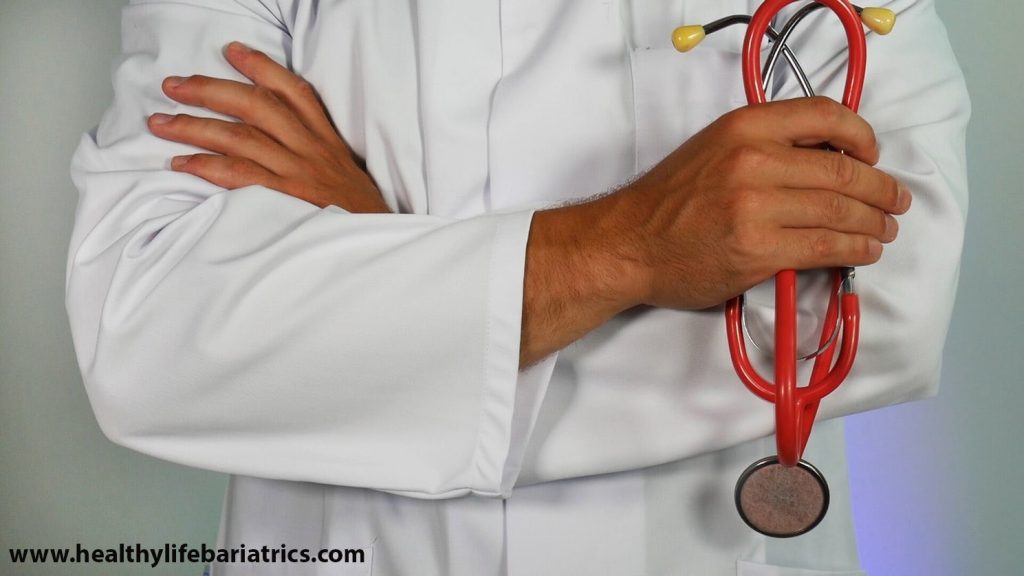
The gastric band (Lap band) and gastric sleeve are two common bariatric (weight loss) surgeries.
Both can help you lose excess weight if you are morbidly obese (which means you have a Body Mass Index (BMI) over 40. At that weight, you are more susceptible to various ailments like type 2 diabetes, sleep apnea, cancer, and early death. Bariatric surgery like the lap band can decrease your risk of those diseases, but the gastric band has fallen out of favor as a viable weight loss procedure.
It wasn’t always that way. The Gastric Band was once thought to be an excellent solution to obesity. By wrapping an adjustable and temporary medical device around the upper portion of your stomach, the Lap-Band limits the amount of food you can eat. You consume fewer calories, leading to fast and significant weight loss.
The problem is. Lately, it’s been discovered that the Lap-Band has a high risk of complications, and many who have the device fail to lose the expected weight. This forces up to 70% of gastric band patients to seek Lap Band Removal after around ten years.
The reasons for seeking the reversal include band slippage, breakage, or symptoms like gastric reflux. By removing the device, many of these issues diminish and disappear.
But to have the adjustable gastric band removed means that your stomach will revert to pre-surgery conditions. It means that you could relapse into old (bad) habits. Any weight you may have lost with the gastric banding could stall or reverse entirely if you end up overeating, which could lead to the dreaded phenomenon of extreme weight regain!
To keep you from gaining weight, bariatric surgeons now have an option. It combines lap band removal surgery with laparoscopic sleeve gastrectomy (LSG). Also known as the gastric sleeve, this amazing weight loss surgery will let you continue your health journey seamlessly without missing a beat. Both surgeries – the removal and gastric sleeve – can be completed in a single procedure for limited downtime and many other positive benefits.
Let’s look at how this 2-in-1 bariatric procedure occurs and, most importantly, determine if it’s safe. Knowledge is power. Knowing these facts will better prepare you for the consultation you are soon to have with a bariatric surgeon near you.

The procedure for removing the lap band is similar to the implantation procedure. If you currently have the lap band, you may have been under general anesthesia during the procedure, so you have no idea how it was performed. Here’s a short rundown.
First, your bariatric surgeon made a series of small incisions in your abdomen. These cuts acted as openings for the laparoscopic tools used during surgery. These tools were operated remotely. They allowed your doctor to work inside your abdominal cavity while viewing the action on a nearby screen.
During that original surgery, the lap band device was secured around the upper portion of your stomach. In many cases, the area around the lap band was also fitted with sutures to keep the gastric banding in place and to prevent slippage.
Gastric band removal uses the same technique, only in reverse.
During the reversal surgery, and unless there were complications during the first one, your surgeon will use the same incisions. The incisions allow the laparoscopic tools to be inserted and the gastric band to be removed.
First, your doctor will cut away any scar tissue that may exist around the gastric lap band. The tubing and banding will be removed before the apparatus is pulled out from around the stomach.
The sutures that ensured your lap band didn’t slip are removed, and the areas around them are treated to prevent infection. With the gastric band removed, your surgeon will often cut away the perigastric capsule, which is dense scar tissue around the upper part of the esophagus or stomach. Performing this extra step prevents obstruction following surgery. Your surgeon will then remove the subcutaneous port before proceeding to the sleeve gastrectomy.
That’s all there is to gastric band removal. Let’s look at the gastric sleeve.
Laparoscopic sleeve gastrectomy (LSG), also called sleeve gastrectomy or simply gastric sleeve, is a permanent weight loss surgery that, like the Lap-Band, restricts the amount of food you can eat. The technique began by altering another bariatric procedure known as the duodenal switch procedure. The doctors soon determined that a gastric sleeve was effective for weight loss. Therefore, many doctors offered weight loss surgery independently, with impressive results!
The gastric sleeve can help you lose up to 80% of your excess weight and is associated with low complication rates. The procedure involves the removal of around 75% of your stomach, which leaves behind a banana-shaped pouch. This pouch or “sleeve” is where you will store the food you eat on its way to being digested. Limiting the amount of food you eat means you consume fewer calories and lose excess weight fast.
Gastric sleeve surgery simultaneously affects the hormones in your body that drive hunger and satiety. This triple threat against obesity means you will eat less, feel less hungry, and feel “full” faster with every meal.
If the lap band fails to work or causes problems, the gastric sleeve ups the ante to ensure you continue losing weight fast, healthy, and without complications or nutritional problems.

In bariatric circles, transitioning from lap band removal to gastric sleeve is called lap band reversal surgery. Lap band reversal allows your surgeon to add another bariatric procedure instead of the failed gastric band. Here is where the gastric sleeve comes into play.
Like the Lap-Band, the doctors perform the sleeve gastrectomy laparoscopically. They don’t need to use new incisions because they can use the same incisions and tools from the gastric band removal surgery.
Your doctor will remove the necessary portion of your stomach and leave the sleeve portion behind before closing the incisions. The good news is that those incisions are typically hidden within the natural folds of your body. Any scarring will be minimized or hidden entirely once they heal.
This combination of Lap-Band Removal and Gastric Sleeve is fairly straightforward. It is an excellent way to resume your weight loss journey if the lap band fails or causes problems.
Now comes the big question: Is it safe?
Of the studies conducted on the efficacy of combining lap band revision and gastric sleeve, all point to the surgery as safe and effective for long-term weight loss.
To be sure, Michigan bariatric surgeon Dr. Hawasli and his associates set out to determine the efficacy of the laparoscopic reversal of the lap band to the gastric sleeve.
Dr. Hawasli and his team followed 489 lap band patients over eight years. Of those patients, 7% went on to have their lap bands reversed to the sleeve gastrectomy. The reasons for the reversal varied. Some experienced slippage, others erosion or infection, while others were unhappy with their weight loss progress.
These patients were now free to experience the benefits of the gastric sleeve, such as satiation, lack of hunger, and the ability to regulate their eating without feeling deprived. Furthermore, unlike other bariatric surgeries that involve the rerouting of your digestive system, like the gastric bypass, the sleeve gastrectomy only involves the removal of part of your stomach. It will not affect other areas of your stomach or digestion, so you are unlikely to suffer from nutrient-related losses or illnesses.
The gastric sleeve has few complication risks, except those with minimally invasive surgery, such as infection, excess bleeding, and side effects like temporary bloating and indigestion, which usually pass before long.
Back to Dr. Hawasli’s experiment. The Lap-Band to gastric sleeve bariatric surgery procedure was not without complications for the patients he studied. One patient experienced leakage due to band erosion and narrowing of the digestive passageways. These complications proved minor. All three patients were under treatment, and the entire group began losing rapid amounts of weight.
Dr. Hawasli concludes gastric band removal to the gastric is safe and viable for long-term weight loss.
The doctor did recommend that patients who experience erosion or narrowing issues because of gastric band wait around six months to complete the lap band reversal with the gastric sleeve.
In some cases, such as if complications of the lap band are present, your doctor may recommend that you complete your gastric band reversal in stages. Common issues include GERD (gastroesophageal reflux disease), food intolerance, band slippage, band erosion or port infection, esophageal dilation, and inadequate weight loss.
The typical waiting time between the lap band reversal and the gastric sleeve is usually six months, though your surgery could be scheduled in as little as three months following lap band removal. The break between surgeries allows your body to heal before the sleeve gastrectomy surgery.
After gastric sleeve surgery, your surgeon will remove the tools from your abdominal cavity before sealing up the incisions. Afterward, you may feel swelling and discomfort at the surgical treatment site. These issues should be resolved on their own within a few days. At most, you could spend a day or two in the hospital before returning home. Expect to rest for around two or three weeks before returning to your usual routine. It would be best if you were back to work within days or up to a week following gastric sleeve surgery.

Whether you wear the Lap-Band or have the gastric sleeve fitted, you will increase your chances of achieving your weight loss goals by living a healthy lifestyle. That includes eating lean meats, healthy carbohydrates, and plenty of vegetables. You can also be healthy by drinking adequate water, eating small meal portions, and exercising regularly.
Your bariatric surgeon can guide you on how and what to eat and when and how to exercise for maximum weight loss. You can also turn to your surgeon and the surgical team for help if you ever run into trouble. With the nature of the gastric sleeve and as a result of the small stomach pouch, you will already consume smaller meals. You only need to fill your stomach with healthier food options. Accomplish that, and healthy weight loss is right around the corner.
.Experienced bariatric surgeon Dr. Moeinolmolki (Dr. Moein) is a Gastric Band Removal to Gastric Sleeve specialist. Call Dr. Moein and his surgical team to find an answer to your questions. You can also schedule a virtual consultation with Dr. Moein to see if this amazing weight loss surgery might be right for you. Call (310)807-1735 to learn more.